Effects of Ecological Restoration and Climate Change on Herbaceous and Arboreal Phenology
Abstract
:1. Introduction
2. Materials and Methods
2.1. Study Area Overview
2.2. Data Source
2.2.1. NDVI Data Source
2.2.2. Temperature Data Source
2.2.3. Precipitation Data Source
2.3. Data Processing
2.3.1. Vegetation Phenology Extraction Method
2.3.2. Trend Analysis Method
2.3.3. Partial Correlation Analysis
3. Results
3.1. Vegetation Phenological Changes in the Horqin Sandy Land
3.2. Relationship between Vegetation Phenology and Climate Factors in the Horqin Sandy Land
3.3. Changes in Meteorological Factors in the Horqin Sandy Land
4. Discussion
4.1. Vegetation Phenological Change Features in the Horqin Sandy Land
4.2. Response of Vegetation Phenology to Climatic Factors in Horqin Sandy Land
4.3. Change Features in Meteorological Factors in the Horqin Sandy Land
5. Conclusions
- Significant changes in vegetation phenology were observed in the Horqin Sandy Land. Both the phenological start date and end dates showed a delayed trend, with change rates of 0.82 days/10a and 5.82 days/10a, respectively. The total phenological period showed an extended trend, with a change rate of 5.00 days/10a, primarily due to the delayed end date. Additionally, the average phenological start date in the sandy land’s forests was around the 129th day, slightly later than the grasslands’ average of 128.68th day. The average phenological end date in the forests was around 286.95th days, later than the grasslands’ average of 283.68th days, resulting in a longer phenological period in forests compared to grasslands.
- The partial correlation between precipitation and phenological factors was generally higher than the partial correlation between temperature and phenological factors in the sandy land. This indicates that precipitation is the primary influencing factor for changes in vegetation phenology. However, there was little difference in the partial correlation between precipitation and phenological factors in forests and grasslands. The partial correlation between temperature and the phenological start date in grasslands was greater than the partial correlation between temperature and the phenological start date in forests. Similarly, the partial correlation between temperature and the phenological end date in forests was greater than the partial correlation between temperature and the phenological end date in grasslands, suggesting that temperature is the main driver of phenological differences between forests and grasslands.
- Within the sandy land, the annual mean NDVI value, precipitation, and temperature increased at rates of 0.01/10a, 93.16 mm/10a, and 0.29 °C/10a, respectively. This indicates that while the climate is warming, the ecological environment in the Horqin Sandy Land is gradually improving due to artificial restoration efforts. The rate of increase in forest ground temperature (0.31 °C/10a) was higher than that in grassland ground temperature (0.21 °C/10a), yet the average ground temperature in grasslands was significantly higher than in forests. The rate of increase in precipitation in forests (106.57 mm/10a) was higher than in grasslands (90.10 mm/10a), and the average precipitation in forests was significantly higher than in grasslands, suggesting that forests have better cooling effects and stronger water holding capacity.
Author Contributions
Funding
Data Availability Statement
Acknowledgments
Conflicts of Interest
References
- Mundinger, C.; van Schaik, J.; Scheuerlein, A.; Kerth, G. Heat over heritability: Increasing body size in response to global warming is not stabilized by genetic effects in Bechstein’s bats. Glob. Chang. Biol. 2023, 29, 4939–4948. [Google Scholar] [CrossRef] [PubMed]
- Hall, N.D.; Stuntz, B.B.; Abrams, R.H. Climate change and freshwater resources. Nat. Resour. Environ. 2008, 22, 30–35. Available online: https://www.jstor.org/stable/40924924 (accessed on 31 July 2023).
- Chen, H.; Zhu, Q.; Peng, C.; Wu, N.; Wang, Y.; Fang, X.; Gao, Y.; Zhu, D.; Yang, G.; Tian, J. The impacts of climate change and human activities on biogeochemical cycles on the Qinghai-Tibetan Plateau. Glob. Chang. Biol. 2013, 19, 2940–2955. [Google Scholar] [CrossRef] [PubMed]
- Cheng, Y.; Zhan, H.; Yang, W.; Dang, H.; Li, W. Is annual recharge coefficient a valid concept in arid and semi-arid regions? Hydrol. Earth Syst. Sci. 2017, 21, 5031–5042. [Google Scholar] [CrossRef]
- Cheng, Y.; Zhan, H.; Yang, W.; Feng, W.; Lu, Q.; Wang, Y.; Jiang, Q.; Wang, B.; Shi, M.; Wang, T. Redistribution process of precipitation in ecological restoration activity of Pinus sylvestris var. mongolica in Mu Us Sandy Land, China. Int. Soil Water Conserv. Res. 2023, 11, 572–585. [Google Scholar] [CrossRef]
- Rammig, A.; Jonas, T.; Zimmermann, N.; Rixen, C. Changes in alpine plant growth under future climate conditions. Biogeosciences 2010, 7, 2013–2024. [Google Scholar] [CrossRef]
- Gordo, O.; Sanz, J.J. Impact of climate change on plant phenology in Mediterranean ecosystems. Glob. Chang. Biol. 2010, 16, 1082–1106. [Google Scholar] [CrossRef]
- Gatti, M.; Pirez, F.J.; Chiari, G.; Tombesi, S.; Palliotti, A.; Merli, M.C.; Poni, S. Phenology, canopy aging and seasonal carbon balance as related to delayed winter pruning of Vitis vinifera L. cv. Sangiovese grapevines. Front. Plant Sci. 2016, 7, 659. [Google Scholar] [CrossRef]
- Shen, M.; Piao, S.; Dorji, T.; Liu, Q.; Cong, N.; Chen, X.; An, S.; Wang, S.; Wang, T.; Zhang, G. Plant phenological responses to climate change on the Tibetan Plateau: Research status and challenges. Natl. Sci. Rev. 2015, 2, 454–467. [Google Scholar] [CrossRef]
- Schurr, U.; Walter, A.; Rascher, U. Functional dynamics of plant growth and photosynthesis–from steady-state to dynamics–from homogeneity to heterogeneity. Plant Cell Environ. 2006, 29, 340–352. [Google Scholar] [CrossRef]
- Fourcaud, T.; Zhang, X.; Stokes, A.; Lambers, H.; Körner, C. Plant growth modelling and applications: The increasing importance of plant architecture in growth models. Ann. Bot. 2008, 101, 1053–1063. [Google Scholar] [CrossRef] [PubMed]
- Cheng, Y.; Zhan, H.; Yang, W.; Jiang, Q.; Wang, Y.; Guo, F. An ecohydrological perspective of reconstructed vegetation in the semi-arid region in drought seasons. Agric. Water Manag. 2021, 243, 106488. [Google Scholar] [CrossRef]
- Cheng, Y.; Yang, W.; Zhan, H.; Jiang, Q.; Shi, M.; Wang, Y.; Li, X.; Xin, Z. On change of soil moisture distribution with vegetation reconstruction in Mu Us sandy land of China, with newly designed lysimeter. Front. Plant Sci. 2021, 12, 609529. [Google Scholar] [CrossRef] [PubMed]
- Sun, W.; Song, X.; Mu, X.; Gao, P.; Wang, F.; Zhao, G. Spatiotemporal vegetation cover variations associated with climate change and ecological restoration in the Loess Plateau. Agric. For. Meteorol. 2015, 209, 87–99. [Google Scholar] [CrossRef]
- Yu, Q.; Yue, D.; Wang, Y.; Kai, S.; Fang, M.; Ma, H.; Zhang, Q.; Huang, Y. Optimization of ecological node layout and stability analysis of ecological network in desert oasis: A typical case study of ecological fragile zone located at Deng Kou County (Inner Mongolia). Ecol. Indic. 2018, 84, 304–318. [Google Scholar] [CrossRef]
- Piao, S.; Fang, J.; Zhou, L.; Ciais, P.; Zhu, B. Variations in satellite-derived phenology in China’s temperate vegetation. Glob. Change Biol. 2006, 12, 672–685. [Google Scholar] [CrossRef]
- Huang, K.; Zhang, Y.; Zhu, J.; Liu, Y.; Zu, J.; Zhang, J. The influences of climate change and human activities on vegetation dynamics in the Qinghai-Tibet Plateau. Remote Sens. 2016, 8, 876. [Google Scholar] [CrossRef]
- Cheng, Y.; Feng, W.; Zhan, H.; Xiao, H.; Xin, Z.; Yang, W. An experimental investigation of precipitation utilization of plants in arid regions. Hydrol. Earth Syst. Sci. Discuss. 2022, preprint. [Google Scholar] [CrossRef]
- Deng, L.; Yan, W.; Zhang, Y.; Shangguan, Z. Severe depletion of soil moisture following land-use changes for ecological restoration: Evidence from northern China. For. Ecol. Manag. 2016, 366, 1–10. [Google Scholar] [CrossRef]
- D’antonio, C.; Meyerson, L.A. Exotic plant species as problems and solutions in ecological restoration: A synthesis. Restor. Ecol. 2002, 10, 703–713. [Google Scholar] [CrossRef]
- Gann, G.D.; McDonald, T.; Walder, B.; Aronson, J.; Nelson, C.R.; Jonson, J.; Hallett, J.G.; Eisenberg, C.; Guariguata, M.R.; Liu, J. International principles and standards for the practice of ecological restoration. Restor. Ecol. 2019, 27, S1–S46. [Google Scholar] [CrossRef]
- Cheng, Y.; Li, X.; Wang, Y.; Zhan, H.; Yang, W.; Jiang, Q. New measures of deep soil water recharge during the vegetation restoration process in semi-arid regions of northern China. Hydrol. Earth Syst. Sci. 2020, 24, 5875–5890. [Google Scholar] [CrossRef]
- Wang, H.; Dai, J.; Ge, Q. The spatiotemporal characteristics of spring phenophase changes of Fraxinus chinensis in China from 1952 to 2007. Sci. China Earth Sci. 2012, 55, 991–1000. [Google Scholar] [CrossRef]
- Buisson, E.; Alvarado, S.T.; Le Stradic, S.; Morellato, L.P.C. Plant phenological research enhances ecological restoration. Restor. Ecol. 2017, 25, 164–171. [Google Scholar] [CrossRef]
- Menzel, A. Phenology: Its importance to the global change community. Clim. Chang. 2002, 54, 379. [Google Scholar] [CrossRef]
- Beatley, J.C. Phenological events and their environmental triggers in Mojave Desert ecosystems. Ecology 1974, 55, 856–863. [Google Scholar] [CrossRef]
- Battin, J.; Wiley, M.W.; Ruckelshaus, M.H.; Palmer, R.N.; Korb, E.; Bartz, K.K.; Imaki, H. Projected impacts of climate change on salmon habitat restoration. Proc. Natl. Acad. Sci. USA 2007, 104, 6720–6725. [Google Scholar] [CrossRef]
- Li, C.; Fu, B.; Wang, S.; Stringer, L.C.; Wang, Y.; Li, Z.; Liu, Y.; Zhou, W. Drivers and impacts of changes in China’s drylands. Nat. Rev. Earth Environ. 2021, 2, 858–873. [Google Scholar] [CrossRef]
- Yan, Y.; Xin, Z.; Bai, X.; Zhan, H.; Xi, J.; Xie, J.; Cheng, Y. Analysis of growing season normalized difference vegetation index variation and its influencing factors on the Mongolian Plateau based on Google Earth Engine. Plants 2023, 12, 2550. [Google Scholar] [CrossRef]
- Lin, M.; Hou, L.; Qi, Z.; Wan, L. Impacts of climate change and human activities on vegetation NDVI in China’s Mu Us Sandy Land during 2000–2019. Ecol. Indic. 2022, 142, 109164. [Google Scholar] [CrossRef]
- Zhang, X.; Friedl, M.A.; Schaaf, C.B.; Strahler, A.H.; Hodges, J.C.; Gao, F.; Reed, B.C.; Huete, A. Monitoring vegetation phenology using MODIS. Remote Sens. Environ. 2003, 84, 471–475. [Google Scholar] [CrossRef]
- Yu, S.; Du, W.; Zhang, X.; Hong, Y.; Liu, Y.; Hong, M.; Chen, S. Spatiotemporal changes in NDVI and its driving factors in the Kherlen River Basin. Chin. Geogr. Sci. 2023, 33, 377–392. [Google Scholar] [CrossRef]
- Zhang, R.; Qi, J.; Leng, S.; Wang, Q. Long-term vegetation phenology changes and responses to preseason temperature and precipitation in Northern China. Remote Sens. 2022, 14, 1396. [Google Scholar] [CrossRef]
- Zheng, G.; Yang, Y.; Yang, D.; Dafflon, B.; Yi, Y.; Zhang, S.; Chen, D.; Gao, B.; Wang, T.; Shi, R. Remote sensing spatiotemporal patterns of frozen soil and the environmental controls over the Tibetan Plateau during 2002–2016. Remote Sens. Environ. 2020, 247, 111927. [Google Scholar] [CrossRef]
- Wang, J.; Gao, G.; Jie, D.; Fang, Q.; Wang, H.; Niu, H.; Meng, M.; Zhang, G.; Liu, Y.; Song, L. Aeolian soils on the eastern side of the Horqin Sandy Land, China: A provenance and sedimentary environment reconstruction perspective. Catena 2022, 210, 105945. [Google Scholar] [CrossRef]
- Xin, Z.; Feng, W.; Zhan, H.; Bai, X.; Yang, W.; Cheng, Y.; Wu, X. Atmospheric vapor impact on desert vegetation and desert ecohydrological system. Plants 2023, 12, 223. [Google Scholar] [CrossRef]
- Zhang, T.-H.; Zhao, H.-L.; Li, S.-G.; Li, F.-R.; Shirato, Y.; Ohkuro, T.; Taniyama, I. A comparison of different measures for stabilizing moving sand dunes in the Horqin Sandy Land of Inner Mongolia, China. J. Arid. Environ. 2004, 58, 203–214. [Google Scholar] [CrossRef]
- Wang, Y.; Zhang, J.; Tong, S.; Guo, E. Monitoring the trends of aeolian desertified lands based on time-series remote sensing data in the Horqin Sandy Land, China. Catena 2017, 157, 286–298. [Google Scholar] [CrossRef]
- Amani, M.; Ghorbanian, A.; Ahmadi, S.A.; Kakooei, M.; Moghimi, A.; Mirmazloumi, S.M.; Moghaddam, S.H.A.; Mahdavi, S.; Ghahremanloo, M.; Parsian, S. Google earth engine cloud computing platform for remote sensing big data applications: A comprehensive review. IEEE J. Sel. Top. Appl. Earth Obs. Remote Sens. 2020, 13, 5326–5350. [Google Scholar] [CrossRef]
- Pettorelli, N. The Normalized Difference Vegetation Index; Oxford University Press: New York, NY, USA, 2013. [Google Scholar] [CrossRef]
- Palmer, T.; Brankovic, C.; Molteni, F.; Tibaldi, S.; Ferranti, L.; Hollingsworth, A.; Cubasch, U.; Klinker, E. The European Centre for Medium-range Weather Forecasts (ECMWF) program on extended-range prediction. Bull. Am. Meteorol. Soc. 1990, 71, 1317–1330. [Google Scholar] [CrossRef]
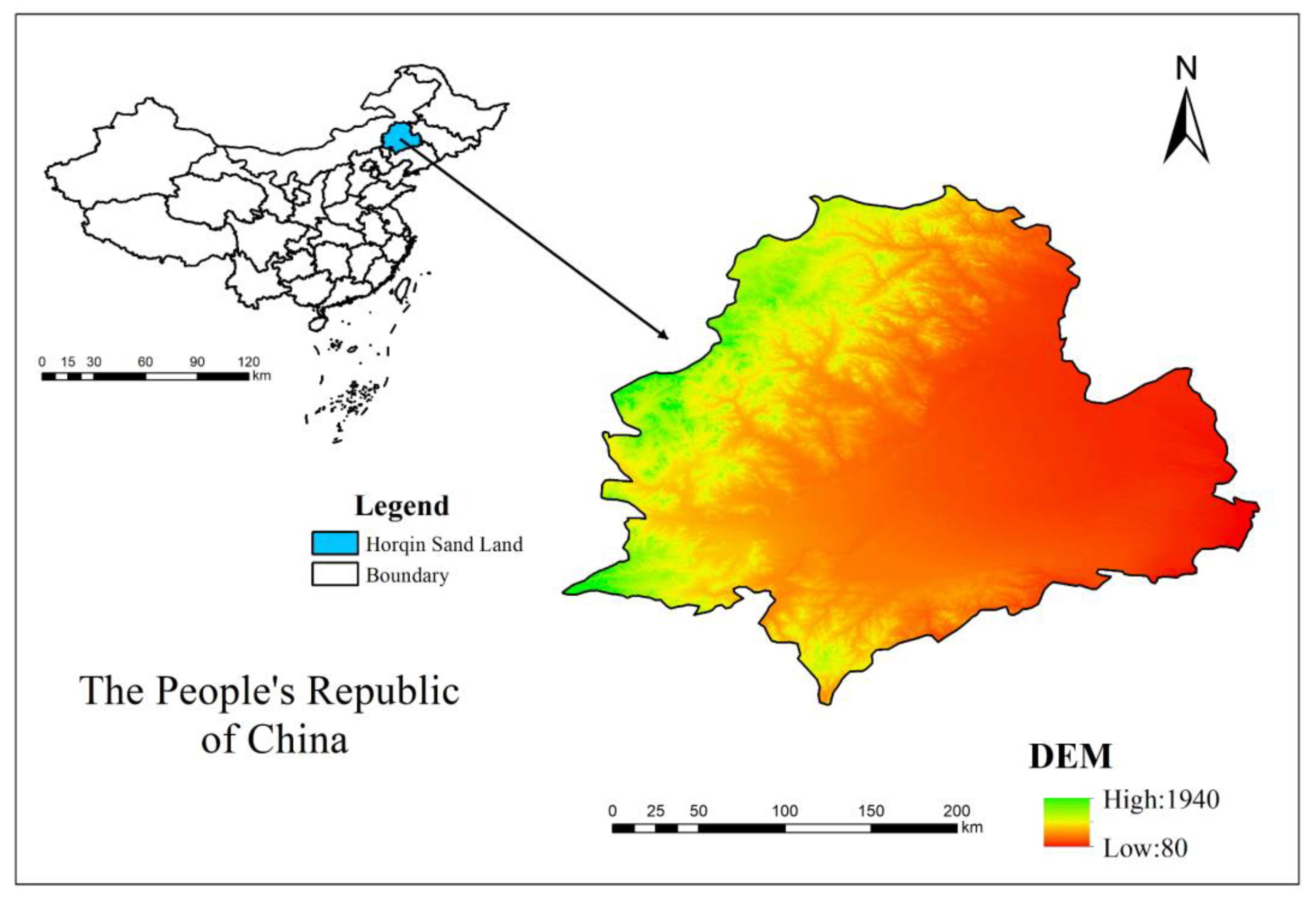

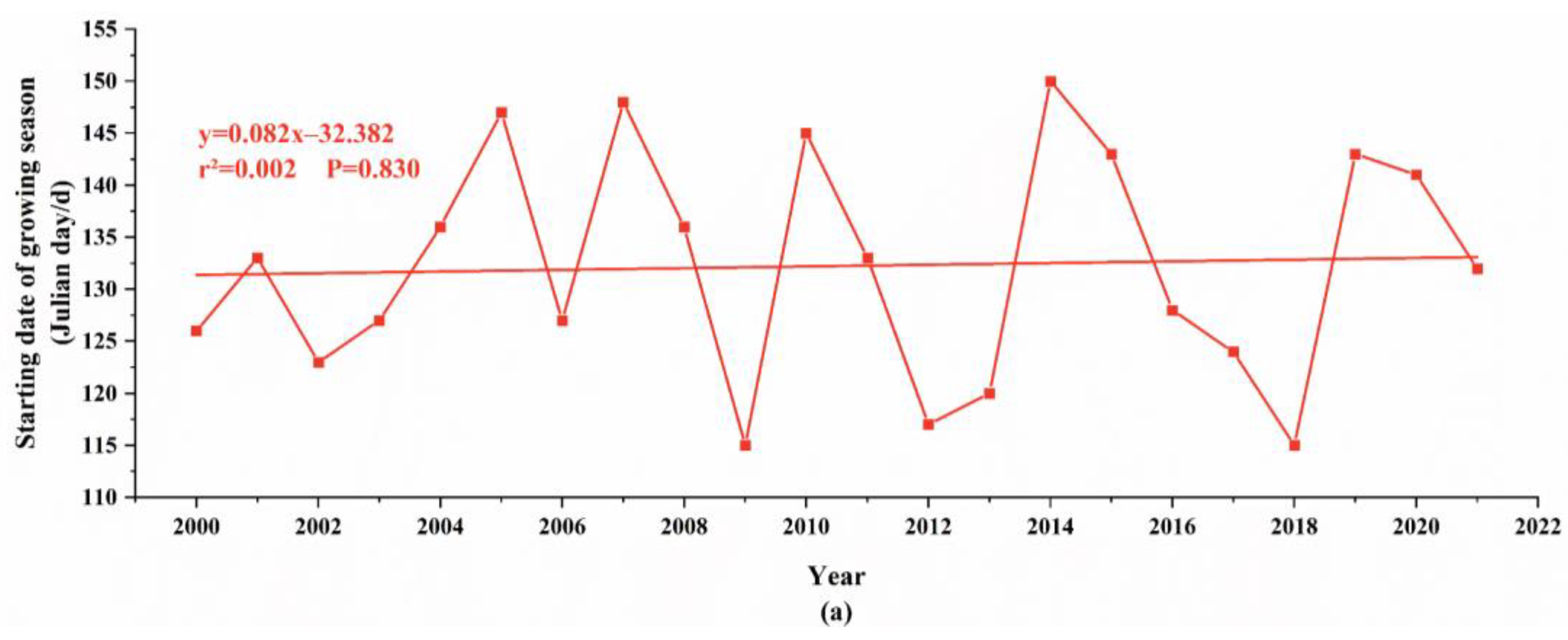
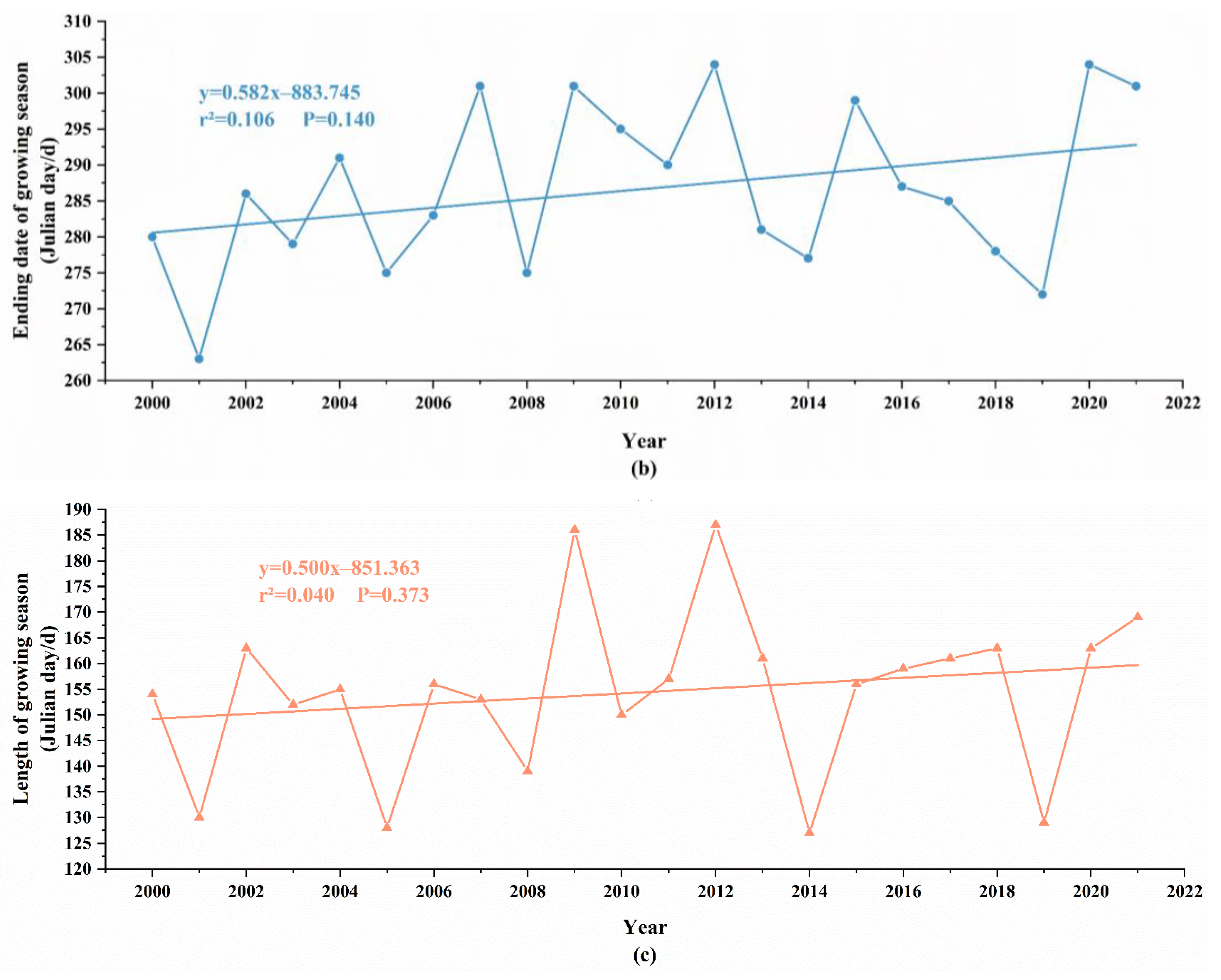
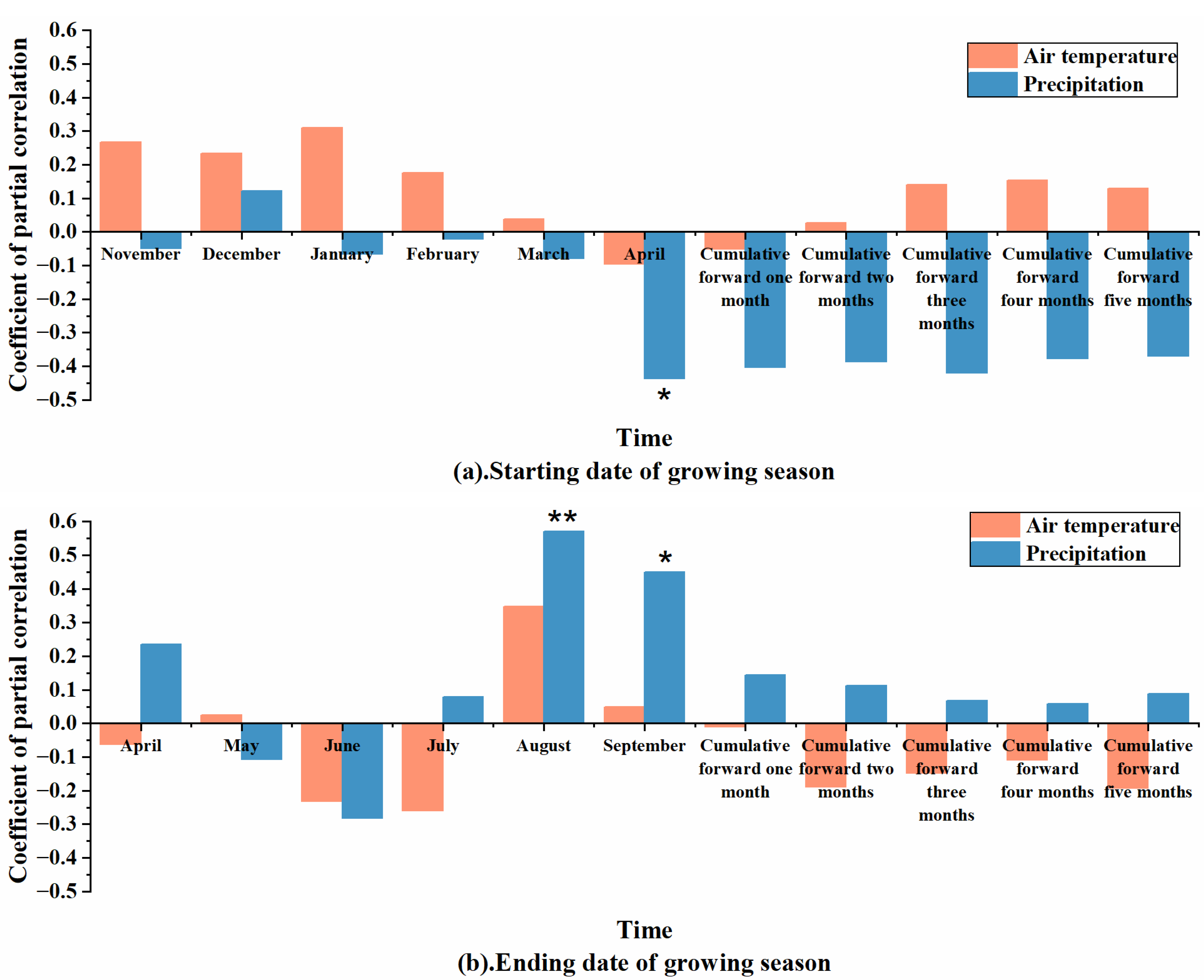

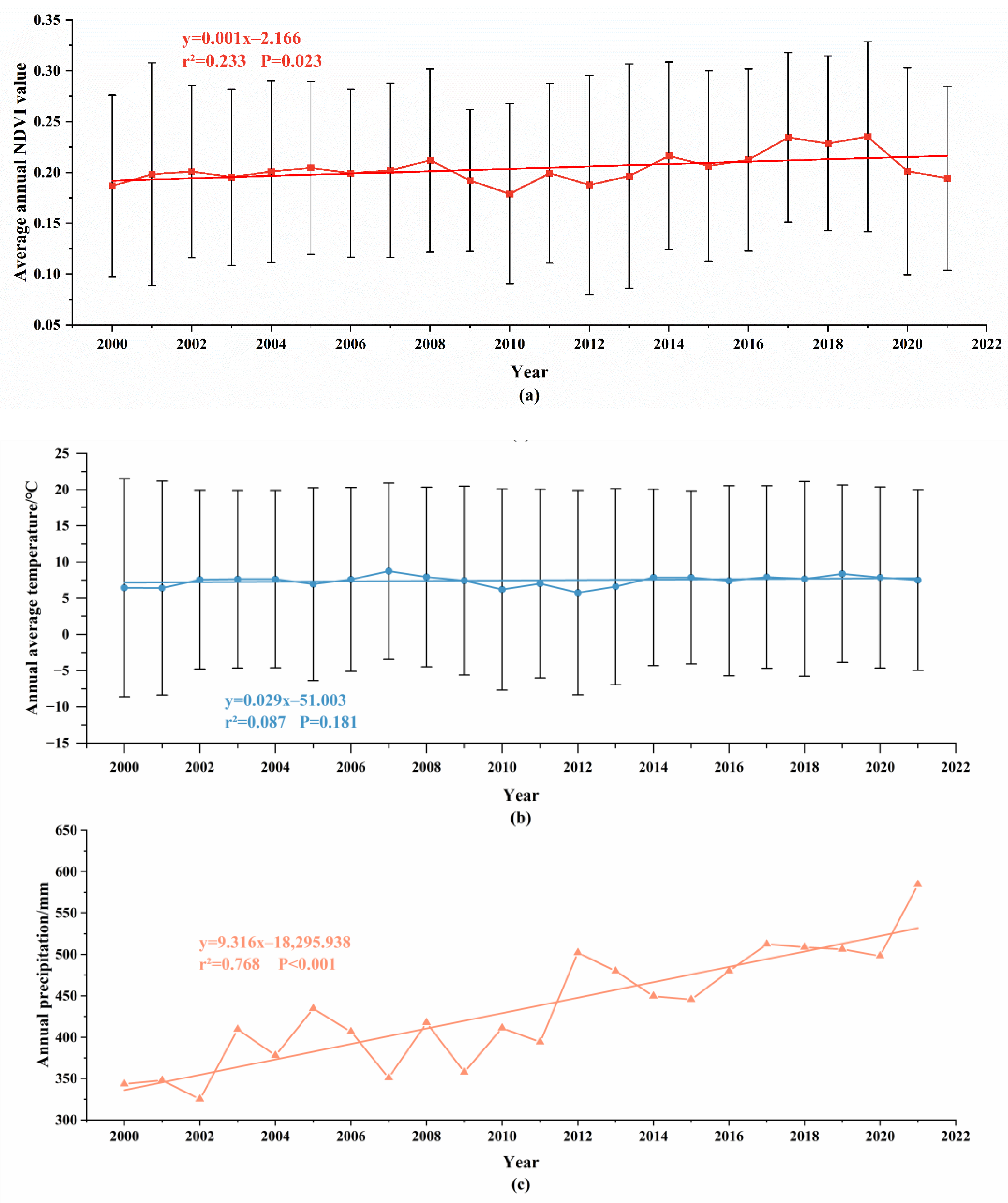

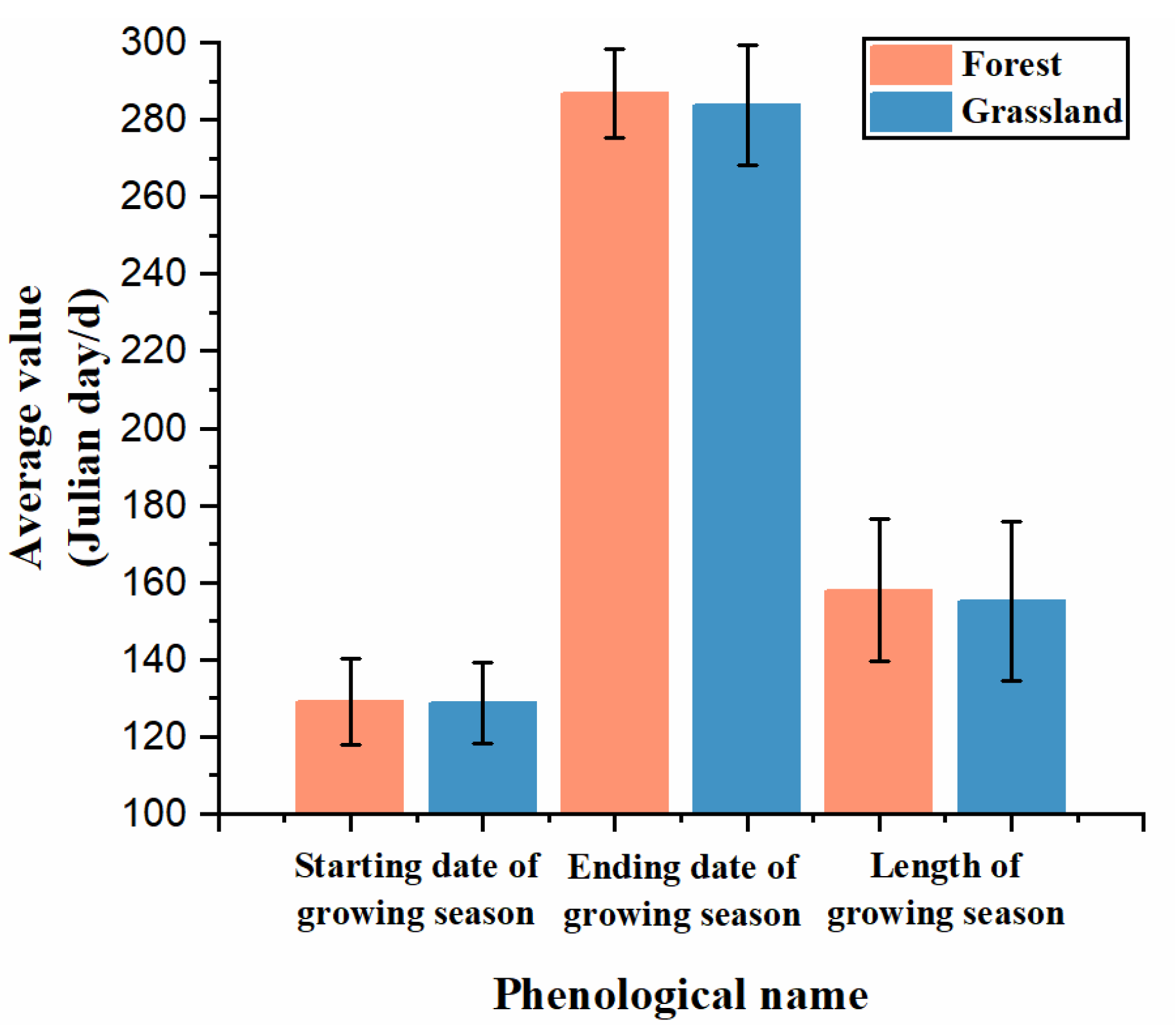
| Data Type | Dataset | Spatial Resolution | Length of Time |
|---|---|---|---|
| NDVI | MODIS/MOD09GA_006_NDVI | 500 m | 1 d |
| Precipitation | UCSB-CHG/CHIRPS/DAILY | 1 km | 1 d |
| Temperature | ECMWF/ERA5_LAND/DAILY_RAW | 1 km | 1 d |
| DEM | NASA/NASADEM_HGT/001 | 30 m | 1 d |
| Year | Average Annual Ground Temperature of Forest/°C | Ground Temperature Variation/°C | Rate of Change/% | Average Annual Ground Temperature of Grassland/°C | Ground Temperature Variation/°C | Rate of Change/% |
|---|---|---|---|---|---|---|
| 2000 | 5.22 | — | — | 6.84 | — | — |
| 2001 | 5.10 | –0.12 | –0.02 | 6.71 | –0.13 | –0.02 |
| 2002 | 6.21 | 1.11 | 0.22 | 8.04 | 1.33 | 0.20 |
| 2003 | 6.17 | –0.04 | –0.01 | 8.04 | –0.01 | 0.00 |
| 2004 | 6.25 | 0.08 | 0.01 | 7.92 | –0.12 | –0.01 |
| 2005 | 5.70 | –0.55 | –0.09 | 7.34 | –0.57 | –0.07 |
| 2006 | 6.34 | 0.65 | 0.11 | 8.09 | 0.74 | 0.10 |
| 2007 | 7.86 | 1.52 | 0.24 | 9.25 | 1.17 | 0.14 |
| 2008 | 6.55 | –1.31 | –0.17 | 8.23 | –1.02 | –0.11 |
| 2009 | 6.24 | –0.31 | –0.05 | 8.23 | 0.00 | 0.00 |
| 2010 | 4.84 | –1.41 | –0.23 | 6.63 | –1.60 | –0.19 |
| 2011 | 5.80 | 0.96 | 0.20 | 7.39 | 0.76 | 0.11 |
| 2012 | 4.27 | –1.53 | –0.26 | 5.48 | –1.91 | –0.26 |
| 2013 | 5.00 | 0.73 | 0.17 | 6.45 | 0.97 | 0.18 |
| 2014 | 6.50 | 1.50 | 0.30 | 8.36 | 1.91 | 0.30 |
| 2015 | 6.37 | –0.12 | –0.02 | 8.27 | –0.09 | –0.01 |
| 2016 | 6.03 | –0.34 | –0.05 | 7.83 | –0.44 | –0.05 |
| 2017 | 6.77 | 0.74 | 0.12 | 8.44 | 0.61 | 0.08 |
| 2018 | 6.27 | –0.50 | –0.07 | 8.13 | –0.31 | –0.04 |
| 2019 | 7.21 | 0.94 | 0.15 | 8.70 | 0.57 | 0.07 |
| 2020 | 6.65 | –0.57 | –0.08 | 7.81 | –0.89 | –0.10 |
| 2021 | 6.10 | –0.55 | –0.08 | 7.44 | –0.37 | –0.05 |
| Year | Average Annual Precipitation of Forest/°C | Precipitation Variation/°C | Rate of Change/% | Average Annual Precipitation of Grassland/°C | Precipitation Variation/°C | Rate of Change/% |
|---|---|---|---|---|---|---|
| 2000 | 337.25 | — | — | 343.83 | — | — |
| 2001 | 354.71 | 17.46 | 0.05 | 341.21 | –2.62 | –0.01 |
| 2002 | 318.43 | –36.28 | –0.10 | 314.64 | –26.57 | –0.08 |
| 2003 | 432.10 | 113.68 | 0.36 | 389.33 | 74.69 | 0.24 |
| 2004 | 379.58 | –52.52 | –0.12 | 365.35 | –23.99 | –0.06 |
| 2005 | 425.13 | 45.55 | 0.12 | 404.62 | 39.27 | 0.11 |
| 2006 | 403.61 | –21.53 | –0.05 | 389.95 | –14.67 | –0.04 |
| 2007 | 326.88 | –76.72 | –0.19 | 348.22 | –41.73 | –0.11 |
| 2008 | 450.31 | 123.43 | 0.38 | 398.47 | 50.25 | 0.14 |
| 2009 | 354.91 | –95.40 | –0.21 | 348.18 | 50.29 | –0.13 |
| 2010 | 376.43 | 21.52 | 0.06 | 409.05 | –60.87 | 0.17 |
| 2011 | 421.23 | 44.80 | 0.12 | 376.74 | –32.31 | –0.08 |
| 2012 | 509.70 | 88.47 | 0.21 | 495.20 | 118.46 | 0.31 |
| 2013 | 491.87 | –17.83 | –0.03 | 464.99 | –30.21 | –0.06 |
| 2014 | 463.00 | –28.87 | –0.06 | 450.43 | –14.56 | –0.03 |
| 2015 | 482.08 | 19.08 | 0.04 | 416.46 | –33.97 | –0.08 |
| 2016 | 463.47 | –18.61 | –0.04 | 466.70 | 50.24 | 0.12 |
| 2017 | 510.91 | 47.44 | 0.10 | 514.24 | 47.54 | 0.10 |
| 2018 | 551.70 | 40.80 | 0.08 | 489.60 | –24.64 | –0.05 |
| 2019 | 497.93 | –53.77 | –0.10 | 479.94 | –9.66 | –0.02 |
| 2020 | 512.52 | 14.59 | 0.03 | 483.93 | 3.99 | 0.01 |
| 2021 | 647.94 | 135.42 | 0.26 | 563.70 | 79.76 | 0.16 |
| Year | Average Annual NDVI Value | NDVI Value Variation | Rate of Change/% |
|---|---|---|---|
| 2000 | 0.187 | — | — |
| 2001 | 0.198 | 0.012 | 0.062 |
| 2002 | 0.201 | 0.003 | 0.013 |
| 2003 | 0.195 | –0.006 | –0.028 |
| 2004 | 0.201 | 0.006 | 0.029 |
| 2005 | 0.205 | 0.004 | 0.018 |
| 2006 | 0.199 | –0.005 | –0.026 |
| 2007 | 0.202 | 0.003 | 0.014 |
| 2008 | 0.212 | 0.010 | 0.049 |
| 2009 | 0.192 | –0.020 | –0.094 |
| 2010 | 0.179 | –0.013 | –0.068 |
| 2011 | 0.199 | 0.020 | 0.112 |
| 2012 | 0.188 | –0.011 | –0.057 |
| 2013 | 0.196 | 0.009 | 0.047 |
| 2014 | 0.216 | 0.020 | 0.101 |
| 2015 | 0.206 | –0.010 | –0.046 |
| 2016 | 0.212 | 0.006 | 0.030 |
| 2017 | 0.234 | 0.022 | 0.103 |
| 2018 | 0.229 | –0.006 | –0.025 |
| 2019 | 0.235 | 0.007 | 0.029 |
| 2020 | 0.201 | –0.034 | –0.145 |
| 2021 | 0.194 | –0.007 | –0.033 |
| Name | Annual Average Temperature | Annual Precipitation |
|---|---|---|
| Annual average NDVI value | 0.657 ** | 0.458 * |
Disclaimer/Publisher’s Note: The statements, opinions and data contained in all publications are solely those of the individual author(s) and contributor(s) and not of MDPI and/or the editor(s). MDPI and/or the editor(s) disclaim responsibility for any injury to people or property resulting from any ideas, methods, instructions or products referred to in the content. |
© 2023 by the authors. Licensee MDPI, Basel, Switzerland. This article is an open access article distributed under the terms and conditions of the Creative Commons Attribution (CC BY) license (https://creativecommons.org/licenses/by/4.0/).
Share and Cite
Yuan, Z.; Cheng, Y.; Mi, L.; Xie, J.; Xi, J.; Mao, Y.; Xu, S.; Wang, Z.; Wang, S. Effects of Ecological Restoration and Climate Change on Herbaceous and Arboreal Phenology. Plants 2023, 12, 3913. https://doi.org/10.3390/plants12223913
Yuan Z, Cheng Y, Mi L, Xie J, Xi J, Mao Y, Xu S, Wang Z, Wang S. Effects of Ecological Restoration and Climate Change on Herbaceous and Arboreal Phenology. Plants. 2023; 12(22):3913. https://doi.org/10.3390/plants12223913
Chicago/Turabian StyleYuan, Zixuan, Yiben Cheng, Lina Mi, Jin Xie, Jiaju Xi, Yiru Mao, Siqi Xu, Zhengze Wang, and Saiqi Wang. 2023. "Effects of Ecological Restoration and Climate Change on Herbaceous and Arboreal Phenology" Plants 12, no. 22: 3913. https://doi.org/10.3390/plants12223913
APA StyleYuan, Z., Cheng, Y., Mi, L., Xie, J., Xi, J., Mao, Y., Xu, S., Wang, Z., & Wang, S. (2023). Effects of Ecological Restoration and Climate Change on Herbaceous and Arboreal Phenology. Plants, 12(22), 3913. https://doi.org/10.3390/plants12223913





